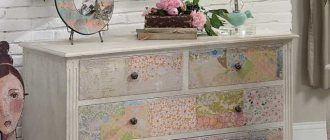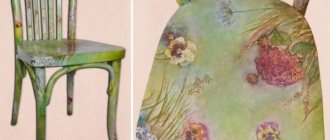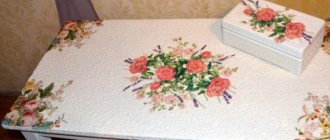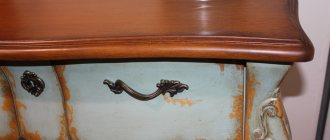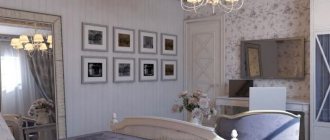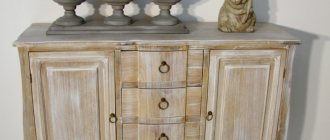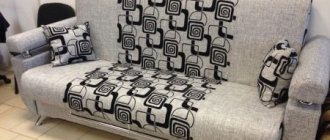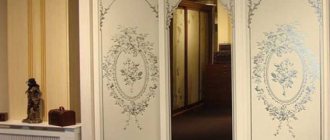Several centuries ago, an interesting technology for decorating furniture appeared in Germany. Not everyone could afford artistic painting back then; people often decorated cabinets, chests of drawers, and boxes with paper pictures, securing them with varnish. This is how the decoupage technique arose, which is still popular today. Today, anyone can decoupage furniture in the Provence style; the master class will help you do everything correctly and avoid common mistakes. The advantage of the technique is that the work does not require special skills or expensive materials.
Features of the decoupage technique
Decoupage is decoration by attaching a cut-out design or ornament to the surface of furniture, dishes, and accessories. To obtain a greater effect and prolong its preservation, the image is coated with varnish. The history of decoupage begins with the Middle Ages:
- The end of the 15th century - in China, pictures were first used to update and decorate pieces of furniture.
- 17th century - in Europe they began to use appliqués in Japanese and Chinese styles, imitating expensive oriental ornaments on cheap furniture. The Italians called this method “the art of the poor.”
- 18th century - in France, at the court of Louis XVI, the works of painters in the Rococo style were used to decoupage furniture.
- 19th century - printed sheets with designs for appliques appeared in England, the first decoupage cards began to be sold in mass quantities.
Nowadays many people are interested in decoupage. Handicraft stores offer special decoupage cards; craftswomen use printed images and fabrics. Thanks to progress, three-dimensional imaging has become possible. The simplest, but no less interesting is the appliqué method using ordinary three-layer napkins.
Additional patination, gilding of objects or crackle (artificial aging) can also be used in tandem with decoupage.
Useful tips from designers
When choosing a sofa for the kitchen, it is important to pay attention to the following qualities:
- The upholstery must be well cleaned from dirt. Textiles must be treated with a special dirt-repellent impregnation. A good option would be cotton, flock, or chenille fabric.
- A frame made of natural wood will last longer. A cheaper option would be chipboard.
- The shape of the sofa directly depends on the size of the kitchen. For a square room, corner models are suitable, and straight ones for an elongated room.
- Functionality: additional storage space, folding option.
The shape of the sofa will depend on the size of the kitchen space.
Although this type of furniture is not very common in the kitchen in our country, it is definitely a convenient and stylish option. To create home comfort, just replace the chairs with a bench or sofa. And manufacturers today offer a huge range of such furniture, which can be used for the interior of a kitchen in the Provence style.
Required materials and tools
To work using the decoupage technique you will need the following tools and materials:
- sandpaper with coarse and fine grains;
- acrylic primer;
- acrylic matte or semi-gloss paint;
- PVA glue;
- acrylic lacquer;
- white spirit or acetone;
- large (10 cm wide) and small brushes;
- multifora;
- spray;
- drawing;
- soft cloth.
You will need two brushes - a narrow one is used for decoupage elements, a wide one is used for applying primer. It is better to purchase synthetic brushes. To paint furniture, you may need foam sponges or a small roller.
The image is chosen at the discretion of the artist. For beginners, it is better to purchase special decoupage cards or rice paper. The motif on this basis will stick without wrinkles and will not tear. More experienced needlewomen choose colored napkins, wallpaper, pieces of fabric, lace, newspapers, and photographs.
If you have no experience in decoupaging furniture, then it is better to start decorating with objects of simple geometric shapes that do not have polished surfaces. Round, curved parts are difficult even for experienced craftsmen.
Tools
Napkins with motifs
Decoupage cards
Rice paper
Preparing the structure
First, you should remove the glass from the furniture, if any. You also need to remove drawers, shelves, and remove all handles. If desired, you can unscrew the hinges and remove the doors to make them easier to handle. After this you need to do the following:
- carefully treat all surfaces with coarse sandpaper, especially for polishing - there should be no gloss left;
- walk with a damp cloth, let dry and repeat the procedure with fine-grain sandpaper;
- degrease with white spirit or acetone;
- coat with ready-made primer or water-soluble glue;
- After a few hours (from 2 to 5), when the surfaces are dry, cover them with acrylic paint.
Classification of furniture handles for cabinets, selection criteria
If one layer is not enough, you can apply a second one. In this case, it is recommended to create the look of careless painting with stripes, as if it was done with a rough, hard brush at the beginning of the last century in Provence. In some places you can leave islands that are not completely painted. Painting can be done using a foam sponge or roller.
The priming brush should be placed in a jar of water to prevent it from drying out. If the paint is thick, it can be slightly diluted with water (up to 5% of the total volume).
Clean the surface of the product with sandpaper
Degrease with white spirit or acetone
Treat with primer
Cover with acrylic paint
Method No. 2
Stock up on the following materials:
- acrylic paint in light colors;
- scissors;
- glue;
- sponge;
- patination powder;
- three-layer napkins;
- sandpaper.
Sequence of work:
- Using sandpaper, we sand the surface, unscrew the handles, and, in general, prepare the cabinet for painting.
- Apply acrylic paint in several layers.
- Cut out the design you like and glue it to the surface using glue. Gently blot off excess glue with a sponge.
- After the glue has dried, you should carefully go around the pattern with sandpaper to give the appearance of light abrasion. By the way, all this should look uneven; you should rely on your aesthetic taste.
- We apply acrylic varnish, and then apply patination powder in random order.
- We cover the surface with several layers of varnish.
Step by step guide
A master class on decoupaging furniture in the Provence style with your own hands includes the following steps:
- First, take napkins or decoupage cards, crop the picture, removing all unnecessary (if necessary). The resulting element is not delaminated - otherwise the design will crawl.
- The white edge of the multifora is cut off - you get 2 films.
- The place where the decoupage element will be located is coated with a thin layer of PVA with a small brush. PVA can be diluted in this case.
- Place the picture face down on half of the multiphore and moisten it with a spray bottle.
- Place the second part of the multifora on top and wipe with a soft cloth. As a result, all wrinkles will disappear, the picture will smooth out well.
- Carefully remove the top film, and apply the picture along with the bottom film to the place that was smeared with glue. Carefully rub the element onto the furniture with a soft cloth over the film.
- Remove the multifore starting from the corner.
- Any moisture around the picture is removed with a rag and, without allowing it to dry, is covered with a thin layer of diluted PVA.
- When the glue in the drawings has dried, the piece of furniture is completely varnished. The layer should not be too thick.
Before starting work, you can practice on a cutting board using one napkin.
If additional aging of furniture is required, then at the final stage the usual acrylic varnish can be replaced with craquelure varnish. Then, when dry, all surfaces will be covered with a network of cracks. In order for the furniture to match the Provence style, abrasions or patination are created on the curves and edges.
Choose napkins with the design you like
Clean the surface
Trim off excess and visually determine the location of the pattern on the furniture
Glue the picture and cover it with a thin layer of diluted PVA glue
When the glue on the drawings has dried, completely cover the surface of the furniture with varnish.
In modern furniture, transparent and smooth glass is installed on the facades, which does not suit the Provence style. Therefore, it makes sense to replace them with matte ones or create an opaque layer yourself. The simplest option is to apply a matte film. In addition to this, you will need to purchase glue in an aerosol can, then proceed as follows:
- wash the glass with detergent and wipe dry;
- cut out a piece of film according to the size of the glass or in the form of separate elements for decoration;
- Carefully remove the protective coating from the film;
- moisten the glass surface and film with a soap solution from a spray bottle;
- Apply the film to the surface and straighten it, expelling air bubbles with a soft cloth.
It is more convenient to glue individual elements one by one.
Wash the glass with detergent and wipe dry
Cut a piece of film to the desired size and carefully remove the protective coating
Moisten the surface and straighten the film
Another matting option is to imitate frost using waterproof acrylic paint in an aerosol can. This method is convenient for applying drawings or patterns using a stencil:
- reusable - it is applied using water-soluble glue;
- disposable - self-adhesive;
- made independently on paper - you will need to transfer it to film, then cut out the desired pattern.
Types of self-adhesive films for furniture, step-by-step application technology
Frost can be removed at any time with acetone. There is another fairly simple method to achieve a matte effect using the following components:
- silicate glue, slightly diluted with water;
- tooth powder to give the consistency of homemade cream;
- water-soluble paint (optional).
All ingredients should be thoroughly mixed until smooth and carefully applied with a roller to the glass to avoid drips. After drying, apply a second coat, and after drying, rinse the glass. With this method, you cannot use a stencil, since during polymerization the composition solders its edges to the glass. There are also various ready-made pastes for chemical etching - they are applied with a spatula to a fat-free, dried surface in a thick layer. Then rub it into the glass, let it stand for 10 minutes, remove the residue, and wash the surface with a sponge.
Imitation of frost with waterproof aerosol acrylic paint
Frosting glass with silicate glue
Tips for care and use
Furniture coated with acrylic varnish does not require special care. Dust can be removed with a soft damp cloth, such as microfiber, followed by wiping dry. At the same time, no streaks should be left. Although primer, paint and varnish provide some protection, large amounts of water can ruin the wood and decorative elements. Grease stains can be removed using a small amount of dishwashing detergent.
It is unacceptable to use abrasive materials or hard brushes when caring for furniture after decoupage to avoid damaging the integrity of varnish, paint and applications. Also, do not use aggressive liquids such as acetone, kerosene, or thinner. If the varnish on individual parts (drawers, doors) wears off over time, it needs to be reapplied. With proper decoupage and careful care, the furniture will last for many years.
If the furniture is coated with acrylic varnish, it does not require special care
When caring for furniture with patterns, you should not use abrasive materials or hard brushes.
With careful care, furniture decorated using the decoupage technique will last for many years.
Aging furniture in the Provence style with your own hands, how to paint?
Modern furniture stores offer a huge selection of furniture in a modern style. But an increasing number of buyers prefer to make Provence furniture with their own hands. The reason is simple: modern style, especially its most fashionable trends like hi-tech and minimalism, is not to everyone’s liking.
The interiors seem faceless and uncomfortable, but if you want to relax your soul at home, then you have to choose another option. This is when less functional and modern, but so cozy, Provence-style solutions come to the rescue.
Cozy interior of a house in Provence style
History and characteristics of Provence
The Provence style direction was formed in one of the provinces of France, from which it got its name. It is believed that Provence as a style was formed in the 19th century, although the first prerequisites for its emergence began to appear 200 years earlier - at a time when cities were actively developing in France.
Despite the simplicity of the solutions and “rustic” origin, Provence was considered an elite style
Even then, some people were tired of the endless bustle of cities, and they sought, if not to change their place of residence, moving closer to nature, then at least to give their apartments and estates a rural charm. Despite the simplicity of the solutions and “rustic” origin, Provence was considered an elite style. This is the solution that families of lawyers and large industrialists preferred to decorate the rooms of.
The main elements of Provence were:
- openness;
- use only natural materials;
- light, “sunny” colors;
- ease.
Provence is characterized by certain details that allow you to create the right mood in the room. First of all, a massive floor, which will only emphasize the lightness of decorative elements and furniture. To create a similar effect, wood or stone is traditionally used as flooring, but it is acceptable to use tiles that imitate natural materials.
Furniture should look like antique
The walls in the premises are not covered with wallpaper. Instead, ordinary brick or stone masonry, carelessly painted or plastered, is used.
The main focus in Provence is on furniture. First of all, it must be old. However, a new one will do, if you first aging the furniture in the Provence style with your own hands. In any case, the furniture should look like antique.
As for decorative items, they need to be selected very carefully and their placement carefully thought through so as not to “overdo it.” Sometimes one simple napkin is enough to give a certain mood.
What should Provence style furniture be like?
As already mentioned, the Provence style dictates two basic rules regarding the furniture used: it should be made of natural materials and with forged metal decorations. Chrome fittings, glass parts, modern wardrobes - all this is absolutely not suitable for such an interior. Therefore, it is better to purchase ready-made furniture or make furniture in the Provence style with your own hands.
All components of the interior are traditionally kept in light colors, less often bright colors are used
All components of the interior are traditionally kept in light colors; bright colors are rarely used. The facades are decorated with bright drawings depicting landscapes, plants, animals or still lifes. Wicker chairs, intricate carvings, antique cabinets and chests, tables and chairs with carved legs, forged cornices - all this will convey the unique atmosphere of the French province. Beds for a Provence style bedroom require the simplest design, but with unusual carved or forged motifs.
As for upholstered furniture, the same rules apply here as for other interior elements. The frames of armchairs and sofas are usually kept in light colors - cream or beige. And you can transform it very simply - with the help of fabric. It must be pleasant to the touch, soft, and in calm colors. Drawings with plant motifs or geometric shapes are welcome.
Bed for a bedroom in Provence style
Furniture aging techniques
There are a huge number of ways to age new furniture, so you can choose the most convenient one. Aging furniture in the Provence style with your own hands allows you to end up with interior elements that will look exactly the same as genuine antique items, but will cost much less.
Ammonia for aging furniture
All methods are divided into 3 groups:
- mechanical aging involves artificially causing scratches, chips, cracks and abrasions on the surface of furniture;
- with thermal, an antiquity effect is created due to the effect of open fire on the surface of the furniture;
- chemical involves treating the surface with stain, craquelure varnish, and ammonia.
If desired, any of these methods allows you to quickly get Provence furniture with your own hands without spending too much effort. But with any processing method, you must first prepare the furniture. This process is also not complicated - just clean the surface and remove all fittings, removable shelves and drawers to make access to the furniture easier.
Bedside table using decoupage technique
All old varnish or paint must be removed from the surface using fine-grit sandpaper. Then the furniture must be thoroughly rubbed with paraffin, without missing a single area. You need to rub, moving along the line of the wood grain.
Then the entire surface must be covered with one or more layers of paint. Aerosol paints are well suited for this, as they allow you to evenly paint the surface, treating all the cracks and hard-to-reach places. Only after this can you begin to age the surface.
Methods for aging furniture
To choose how to age the surface, you can take a look at the master class on making Provence furniture with your own hands.
Paraffin for aging furniture
In order to visually age the furniture, after treatment with paraffin and staining, it will be enough to wipe the surface with a sponge.
Important! It is important not to overdo it here, since if there are too many “bare” areas, the effect will not be achieved.
After such processing, it is necessary to consolidate the result. To do this, you need to treat the furniture with one or two layers of varnish.
Another way to make Provence furniture with your own hands is to use “steel wool”, which is sold in the hardware department. This material is also called steel wool and is intended specifically for polishing furniture.
Black steel wool for furniture processing
For processing you will need black steel wool. The surface needs to be prepared - remove the old coating and re-paint (as in the first case). Then use metal wool to “walk” over the surface with confident movements. The result will be a layer of “soot.” After this, wipe with a damp cloth so that some of the “soot” is partially erased, then wipe with a dry cloth. You will get beautiful “scuffs”. The fittings need to be treated in exactly the same way.
An original way to get furniture in the Provence style is to age it using crackle varnish. Two-component varnish must be applied in at least 2 layers using a brush with natural bristles. The more layers there are, the more cracks will result. The varnish should be left to dry for 40 minutes. You can speed up drying by using a hair dryer. The cracks need to be treated with dark oil-based paint or bitumen, then apply another layer of varnish, but this time regular one.
Painting furniture in Provence style
Before decorating, sometimes it is necessary to update the appearance of old furniture. Painting is quite suitable for this. Using the same method, you can hide the material from which the furniture façade is made that is “inappropriate” for the Provence style.
The Provence style is characterized by light, muted tones.
If the furniture is old, then all surface imperfections must first be eliminated. If there is already an old layer of paint, it must be removed, otherwise the surface will be uneven. In addition, the old paint will begin to crumble over time, so the table (or other piece of furniture) will not be pleasing with its attractive appearance for a long time. You need to remove old paint using sandpaper. You can use coarser grains first, and then finer ones. It is better to unscrew the handles and all fittings so that you can treat the area underneath them.
Typically, the Provence style is characterized by light, muted tones - beige, cream, light gray. Facades, surfaces, corners and internal shelves must be painted very carefully, without leaving untreated areas. After the paint has dried, the surface can be coated with a layer of varnish. Let the varnish dry and then wipe the surface with a dry cloth.
Sandpaper for removing old paint from furniture
Clean furniture handles with a steel brush, wipe well and return to their place.
If the design includes internal drawers, then you need to put a piece of matching fabric on the bottom and secure it well with glue.
Technique for decoupage furniture in Provence style
After aging, you can additionally decorate the furniture in the Provence style with your own hands. Decoupage will look good on new furniture and will add charm to familiar old furniture. You don't need artistic ability to complete all the steps.
Plant motifs, pictures with pets, flower bouquets, still lifes and rural landscapes are best suited for the Provence style. You
don’t need to draw the images yourself; you can pick them up on the Internet, for example in handicraft groups, or purchase special napkins with a pattern. If the drawing is to be printed, it is better to do it on a laser printer, otherwise the colors will wash out.
Important! Plant motifs, pictures with pets, flower bouquets, still lifes and rural landscapes are best suited for the Provence style.
If the surface has already been artificially aged, then you can immediately proceed to applying the image. If not, first prepare the surface in the usual way: remove old paint with sandpaper, apply light paint and wait until it dries.
You don’t need to draw the images yourself; you can pick them up on the Internet, for example in handicraft groups, or purchase special napkins with a pattern
To decoupage furniture in the Provence style with your own hands, you need to prepare:
- drawing;
- glue stick (you can use PVC glue instead);
- sponge (regular, intended for washing dishes);
- scissors;
- varnish
The selected design must be cut out, a small amount of glue applied to the back and applied to the surface. If necessary, remove any remaining adhesive by gently blotting with a sponge.
Decoupage will look good on new furniture and will add charm to familiar old furniture.
Let the glue dry. In the first hour after gluing, air bubbles sometimes appear. To make them smaller, before applying the glue, the pattern can be placed in water for a few seconds. Your hands should also be slightly damp while gluing. It is important to notice and eliminate bubbles in time so that the drawing does not deteriorate. After this, rub gently with sandpaper next to the drawing to make abrasions. Apply a layer of varnish to the surface, and after drying, apply patina powder in several places. Apply 2 more layers of varnish to consolidate the result.
The desired decoupage effect can be achieved in another way. To do this, you will need fabric with a bright floral pattern to upholster the furniture with. Complete with forged elements and stylish fittings.
Furniture painting in Provence style
The most complex and time-consuming method of decoration is painting furniture in the Provence style with your own hands. In this case, the ability to draw beautifully will be useful and will make the work easier. And yet, the efforts will pay off: the furniture will acquire a special French charm and become truly unique.
The most complex and time-consuming way to decorate is to paint furniture in the Provence style with your own hands.
Before you get to work, you need to select a pattern sample and select paints. Acrylic paints of white and one color close to white, but several tones darker, are suitable for painting.
First you need to paint the surface in two layers. It is necessary to paint it white, and a darker second layer.
After painting furniture in the Provence style with your own hands, you need to wait until the paint has dried completely, and you can apply drawings to the facades and sides. You need to draw a sketch with a pencil, but before painting, be sure to rub the contours a little, since after painting the pencil is sometimes noticeable. Apply a layer of oil varnish on top and wait 3.5 hours. After this, apply water-soluble varnish. If you then blow a little hairdryer over the surface of the drawing, it will turn out slightly blurred.
Acrylic paints of white and one color close to white, but several tones darker, are suitable for painting.
You can decorate the façade of Provence furniture with your own hands using gold paint. Small sparkles can be made using a regular brush. You need to apply the paint carefully, it is important not to overdo it. An abundance of gold paint will only spoil the appearance of the furniture.
When the varnish is completely dry, all that remains is to add handles that match the style. After this, you can consider that the decoration is finished. On a table decorated in this way, you can place a nice vase with flowers, a lamp with a fabric lampshade, or any other accessories in the Provencal style.
What do you think about it?
Leave a comment, your opinion is important to us 😻
